Demand Flexibility Enabled by Virtual Energy Storage to Improve Renewable Energy Penetration
Abstract
1. Introduction
2. Methodology and Tools
2.1. The PLANET DSS Tool
- The web User Interface (UI) and orchestration module: IDOC (Integrated Decision Support System and Orchestration Cockpit);
- The energy conversion and storage asset models (P2G, P2H and VES);
- The system optimisation module: SCCE (District-Level Storage/Conversion Coordination Engine);
- The grid simulation component.
2.2. Virtual Energy Storage (VES) as a Flexibility Asset
2.2.1. Virtual Energy Storage Technology within the PLANET Framework
2.2.2. VES Model Description
2.2.3. The VES Module: Architecture and Interfaces
3. The Analysed Scenario
- Base Case (BC): The VES-enabled flexibility is not exploited and the end-user demand; therefore, remains at its baseline value. The indoor temperature of the buildings is maintained at the baseline value that maximises the thermal comfort of the occupants.
- Optimisation Case 1 (OC1): The VES-enabled flexibility is estimated and utilised with the objective of maximising the absorption of the local RESs generation. During these periods, the temperature of the building is increased, without violating the upper temperature boundary, which was estimated during the profiling of the occupants’ thermal comfort. During time periods in which there is no RESs over-production, the end-users’ demand follows the baseline trend.
- Optimisation Case 2 (OC2): The VES-enabled flexibility is utilised to obtain the maximum absorption of local RESs generation through the same approach as that of OC1. However, during the periods of time when there is no RESs production, the buildings adopt a strategy of minimised energy consumption through the control of their LP2H systems at the lower comfort temperature boundary, which is based on the results of the comfort profiling. In this way, the storage capacity of the VES-enabled building is maximised, as it increases the allowed temperature variation while following a building-level energy efficiency strategy.
- Reverse Power Flow (RFP): The RPF is calculated for each scenario as the surplus production (in kWh) of the RESs generation that is not absorbed locally or timely.where is the total generation in the scenario at time step and is the total consumption of the investigated part of the grid.
- Grid Self-Sufficiency (Ss): The grid Self-Sufficiency () represents the percentage of electricity demand that is covered by the local PV production:where is the total PV production and is the total electric consumption of the local grid. The higher the Grid Self-Sufficiency is, the less electric energy withdrawn from the transmission grid. Since the distributed generation considered in this scenario was composed of RESs generators, this metric is also representative of RESs penetration.
- Grid Self-Consumption (Sc): The grid Self-Consumption represents the percentage of PV electricity production that is consumed locally in the scenario. The higher the value of this KPI is, the lower the amount of RESs overproduction that is transformed to RPF.
- Thermal Discomfort Indicator (TDI): PLANET VES-enabled flexibility profiling is comfort preserving, in the sense that it takes into account the upper and lower comfort temperature boundaries as inherent optimisation constraints. These temperature thresholds are inferred from thermal comfort profiling (as described in Section 2.2.2) and represent a compromise status in which the occupant has a higher probability of being in a state of comfort that in discomfort. However, an optimal comfort is achieved when the temperature lies within the narrower range defined as the baseline comfort temperature zone. To this end, the lower “comfort indicator” is calculated for each of the optimisation cases:The above KPI refers to a benchmark building and constitutes a metric that includes both the temperature deviation from the Base Case temperature and the time duration of such a deviation. The Thermal Discomfort Indicator (TDI) is expressed in {°C∙h}, and the smaller the value is, the lower the deviation from the preservation of optimal comfort during demand modulation events.
4. Results and Discussion
5. Conclusions
Author Contributions
Funding
Acknowledgments
Conflicts of Interest
References
- Meinshausen, M.; Meinshausen, N.; Hare, W.; Raper, S.C.; Frieler, K.; Knutti, R.; Frame, D.J.; Allen, M.R. Greenhouse-gas emission targets for limiting global warming to 2 C. Nature 2009, 458, 1158–1162. [Google Scholar] [CrossRef] [PubMed]
- Seeley, J.T.; Romps, D.M. The Effect of Global Warming on Severe Thunderstorms in the United States. J. Clim. 2015, 28, 2443–2458. [Google Scholar] [CrossRef]
- United Nations Climate Change. What Is the Paris Agreement? Available online: https://unfccc.int/process-and-meetings/the-paris-agreement/what-is-the-paris-agreement (accessed on 8 July 2020).
- European Commission. Clean Energy for All Europeans; Publications Office of the European Union: Luxembourg, Luxembourg, 2019. [Google Scholar]
- Lehtveer, M.; Mattsson, N.; Hedenus, F. Using resource based slicing to capture the intermittency of variable renewables in energy system models. Energy Strat. Rev. 2017, 18, 73–84. [Google Scholar] [CrossRef]
- Jacobson, M.Z.; Delucchi, M.A.; Bauer, Z.A.; Goodman, S.C.; Chapman, W.E.; Cameron, M.A.; Bozonnat, C.; Chobadi, L.; Clonts, H.A.; Enevoldsen, P.; et al. 100% Clean and Renewable Wind, Water, and Sunlight All-Sector Energy Roadmaps for 139 Countries of the World. Joule 2017, 1, 108–121. [Google Scholar] [CrossRef]
- Andrychowicz, M. Comparison of the Use of Energy Storages and Energy Curtailment as an Addition to the Allocation of Renewable Energy in the Distribution System in Order to Minimize Development Costs. Energies 2020, 13, 3746. [Google Scholar] [CrossRef]
- Chicco, G.; Riaz, S.; Mazza, A.; Mancarella, P. Flexibility from Distributed Multienergy Systems. Proc. IEEE. 2020, 108, 1496–1517. [Google Scholar] [CrossRef]
- Ciocia, A.; Boicea, V.A.; Chicco, G.; Di Leo, P.; Mazza, A.; Pons, E.; Spertino, F.; Hadj-Said, N. Voltage control in low-voltage grids using distributed photovoltaic converters and centralized devices. IEEE Trans. Ind. Appl. 2018, 55, 225–237. [Google Scholar] [CrossRef]
- Diaz-Londono, C.; Colangelo, L.; Ruiz, F.; Patino, D.; Novara, C.; Chicco, G. Optimal Strategy to Exploit the Flexibility of an Electric Vehicle Charging Station. Energies 2019, 12, 3834. [Google Scholar] [CrossRef]
- De Luca, G.; Ballarini, I.; Lorenzati, A.; Corrado, V. Renovation of a social house into a NZEB: Use of renewable energy sources and economic implications. Renew. Energy 2020, 159, 356–370. [Google Scholar] [CrossRef]
- Badami, M.; Fambri, G. Optimising energy flows and synergies between energy networks. Energy 2019, 173, 400–412. [Google Scholar] [CrossRef]
- Jin, X.; Wang, X.; Mu, Y.; Jia, H.; Xu, X.; Qi, Y.; Yu, X.; Qi, F. Optimal scheduling approach for a combined cooling, heating and power building microgrid considering virtual storage system. In Proceedings of the 2016 IEEE Power and Energy Society General Meeting (PESGM), Tianjin, China, 17 July 2016. [Google Scholar]
- Sikder, O.; Jansson, P.M. Thermal inertia of a building as virtual energy storage: A sustainable solution for smart grids. In Proceedings of the 2018 53rd International Universities Power Engineering Conference (UPEC), Glasgow, Scotland, 4–6 September 2018. [Google Scholar]
- Asare, P.; Ononuju, C.; Jansson, P.M. Preliminary quantitative evaluation of residential virtual energy storage using power sensing. In Proceedings of the 2017 IEEE Sensors Applications Symposium (SAS), Glassboro, NJ, USA, 13–15 March 2017. [Google Scholar]
- PLANET. Planning and Operational Tools for Optimising Energy Flows & Synergies Between Energy Networks. Available online: https://www.h2020-planet.eu/ (accessed on 8 July 2020).
- Katsiki, V.; Papanikolaou, A.; Sideris, D.; Makris, S.T.; Nikolopoulos, D.; Petridis, K.; Schröder, A.; Breuers, M.; Mirtaheri, H.; Bortoletto, A.; et al. Deliverable D1.5 PLANET System Architecture Definition, PLANET. 2019. Available online: https://www.h2020-planet.eu/deliverables (accessed on 1 August 2020).
- Papanikolaou, A.; Katsiki, V.; Sideris, D.; Mazza, A.; Estebsari, A.; Mirtaheri, H.; Damousis, Y.; Kakardakos, N.; Faropoulos, J.; Skiadaresis, G. Deliverable D1.4 PLANET System Architecture Definition, PLANET. 2019. Available online: https://static1.squarespace.com/static/5a3297ded7bdce9ea2f39f1a/t/5ddd2a00c833493f056f2a08/1574775315046/D1.4_Planet_Final_PU.pdf (accessed on 8 July 2019).
- Badami, M.; Fambri, G.; Mancò, S.; Martino, M.; Damousis, I.G.; Agtzidis, D.; Tzovaras, D. A Decision Support System Tool to Manage the Flexibility in Renewable Energy-Based Power Systems. Energies 2019, 13, 153. [Google Scholar] [CrossRef]
- Bottaccioli, L.; Patti, E.; Macii, E.; Acquaviva, A. Distributed Infrastructure for Multi-Energy-Systems Modelling and Co-simulation in Urban Districts. In Proceedings of the 7th International Conference on Smart Cities and Green ICT Systems (SMARTGREENS), Funchal, Portugal, 16–18 March 2018. [Google Scholar]
- eMEGAsim, Power System and Power Electronic Real-Time Simulator, OPAL-RT. Available online: http://www.opal-rt.com/new-product/emegasim-power-system-and-power-electronic-real-time-simulator (accessed on 11 June 2020).
- Bottaccioli, L.; Estebsari, A.; Patti, E.; Pons, E.; Acquaviva, A. Planning and real-time management of smart grids with high PV penetration in Italy. Proc. Inst. Civ. Eng. Eng. Sustain. 2018, 172, 272–282. [Google Scholar] [CrossRef]
- Bian, D.; Kuzlu, M.; Pipattanasomporn, M.; Rahman, S.; Wu, Y. Real-time co-simulation platform using OPAL-RT and OPNET for analyzing smart grid performance. In In Proceedings of the 2015 IEEE Power & Energy Society General Meeting, Denver, CO, USA, 26–30 July 2015. [Google Scholar]
- Mirtaheri, H.; Bortoletto, A.; Fantino, M.; Bertone, F.; Li, Y.; Damousis, Y.; Agtzidis, D.; Katsiki, V.; Papanikolaou, A.; Schröder, A.; et al. Deliverable D3.5 District-Level Storage and Conversion Management & Coordination Engine (SCCE). PLANET 2019, in press. [Google Scholar]
- Barooah, P. Virtual energy storage from flexible loads: Distributed control with QoS constraints. In Smart Grid Control; Stoustrup, J., Anuradha Annaswamy, A., Chakrabortty, A., Qu, Z., Eds.; Springer: Cham, Switzerland, 2019; pp. 99–115. [Google Scholar]
- Eurelectric; EY. Report on the Future Role of DSOs in Europe. Getting Ready: DSO 2.0. 2019. Available online: https://www.eurelectric.org/media/3637/ey-report-future-of-dsos.pdf (accessed on 8 July 2020).
- Klaassen, E.; Van der Laan, M. Energy and Flexibility Services for Citizens Energy Communities. U.S.E. Framework. 2019. Available online: https://www.buildup.eu/sites/default/files/content/usef-white-paper-energy-and-flexibility-services-for-citizens-energy-communities-final-cm.pdf (accessed on 8 July 2020).
- Makris, S.; Nikolopoulos, D.; Ververidis, C.; Katsiki, V.; Badami, M.; Fambri, G.; Granroth-Wilding, H.; Hussam, S.; Soppela, O.; Kakardakos, N.; et al. Deliverable D3.3 PLANET P2H-Enabled Human-Centric VES Module, PLANET. 2019. Available online: https://static1.squarespace.com/static/5a3297ded7bdce9ea2f39f1a/t/5ddd2ab2880bee4473692781/1574775481127/D3.3_Planet_Final_PU.pdf (accessed on 8 July 2019).
- Malavazos, C.; Tsatsakis, K.; Tsitsanis, A. Towards a “context aware” flexibility profiling mechanism for the energy management environment. In Proceedings of the MedPower Conference, Athens, Greece, 2–5 November 2014. [Google Scholar]
- Seungjae, L.; Bilionis, I.; Karava, P.; Tzempelikos, A. A Bayesian Approach for Learning and Predicting Personal Thermal Preference. In Proceedings of 4th International High-Performance Buildings Conference, West Lafayette, IN, USA, 11–14 July 2016. [Google Scholar]
- Enescu, D. A review of thermal comfort models and indicators for indoor environments. Renew. Sustain. Energy Rev. 2017, 79, 1353–1379. [Google Scholar] [CrossRef]
- Papanikolaou, A.; Nassos, T.; Alexandros, D.; Dionisis, N.; Katsiki, V.; Fantino, M.; Kakardakos, N.; Faropoulos, j.; Skiadaresis, G.; Vourkas, H.; et al. Deliverable D2.3 Human-Centric, Context-Aware VES Demand Flexibility Profiles, PLANET. 2019. Available online: https://www.h2020-planet.eu/s/D23_Planet_Final_PU.pdf (accessed on 8 July 2019).
- Dall’O, G. Green Energy Audit of Buildings: A Guide for a Sustainable Energy Audit of Buildings; Springer: London, UK, 2013. [Google Scholar]
- Bacher, P.; Madsen, H. Identifying suitable models for the heat dynamics of buildings. Energy Build. 2011, 43, 1511–1522. [Google Scholar] [CrossRef]
- Katsiki, V.; Ververidis, C.; Petridis, K.; Bompard, E.; Chicco, G.; Chomaz, R.; Agtzidis, D.; Damousis, Y.; Tsotakis, C.; Afentoulis, K.; et al. Deliverable D5.3; Simulation Lab Set-up and VES Model Calibration Report, PLANET. 2020. in press. Available online: https://www.h2020-planet.eu/deliverables (accessed on 8 July 2019).
- Camacho, E.F.; Alba, C.B. Model Predictive Control; Springer Science & Business Media: Berlin/Heidelberg, Germany, 2013. [Google Scholar]
- Genest, O.; Pons, L.; Valckenaers, P.; Crihan, F. Main Findings and Recommendations: Data Management Working Group; BRIDGE Horizon 2020. 2019. Available online: https://www.h2020-bridge.eu/wp-content/uploads/2018/06/BRIDGE-Data-Management-WG-Findings-and-Reco-July-2019.pdf (accessed on 8 July 2019).
- Damousis, Y.; Agtzidis, D.; Badami, M.; Fambri, G.; Diaz-Londono, C. Deliverable D4.2 PLANET Communication Middleware Development & Configuration; PLANET. 2019. Available online: https://static1.squarespace.com/static/5a3297ded7bdce9ea2f39f1a/t/5ddd2b96516b877c21373f38/1574775708936/D4.2_Planet_Final_PU.pdf (accessed on 8 July 2019).
- Carpaneto, E.; Chicco, G. Probability distributions of the aggregated residential load. In Proceedings of the 9th International Conference on Probabilistic Methods Applied to Power Systems, Stockholm, Sweden, 11–15 June 2006. [Google Scholar]
- SOREA. Available online: https://www.sorea-maurienne.fr/ (accessed on 20 March 2020).
- Renewables.ninja. Available online: https://www.renewables.ninja/ (accessed on 20 March 2020).
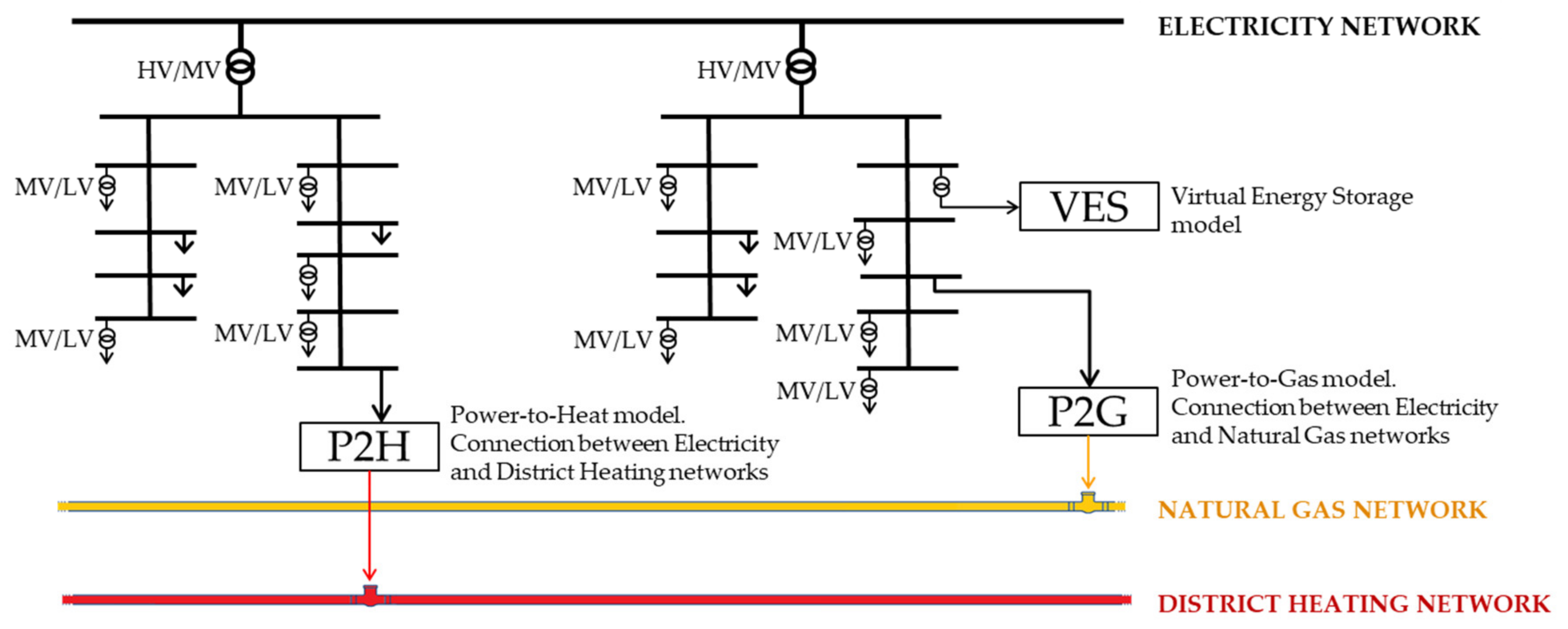
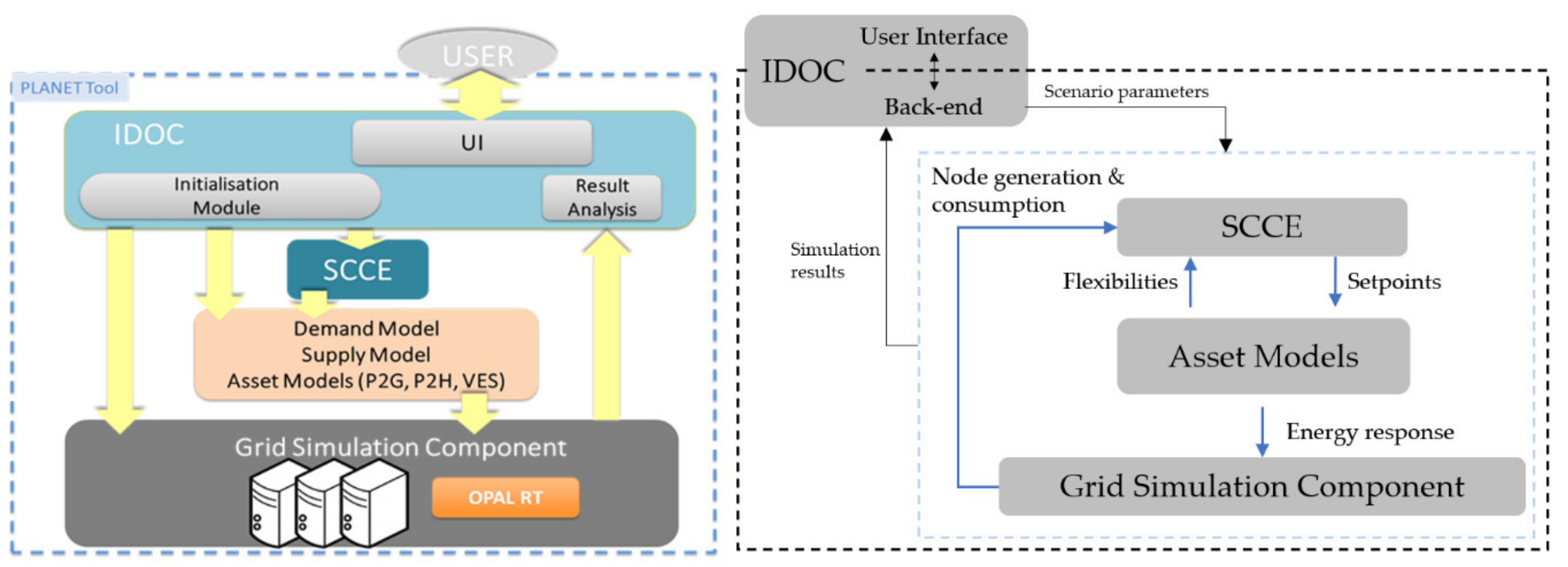
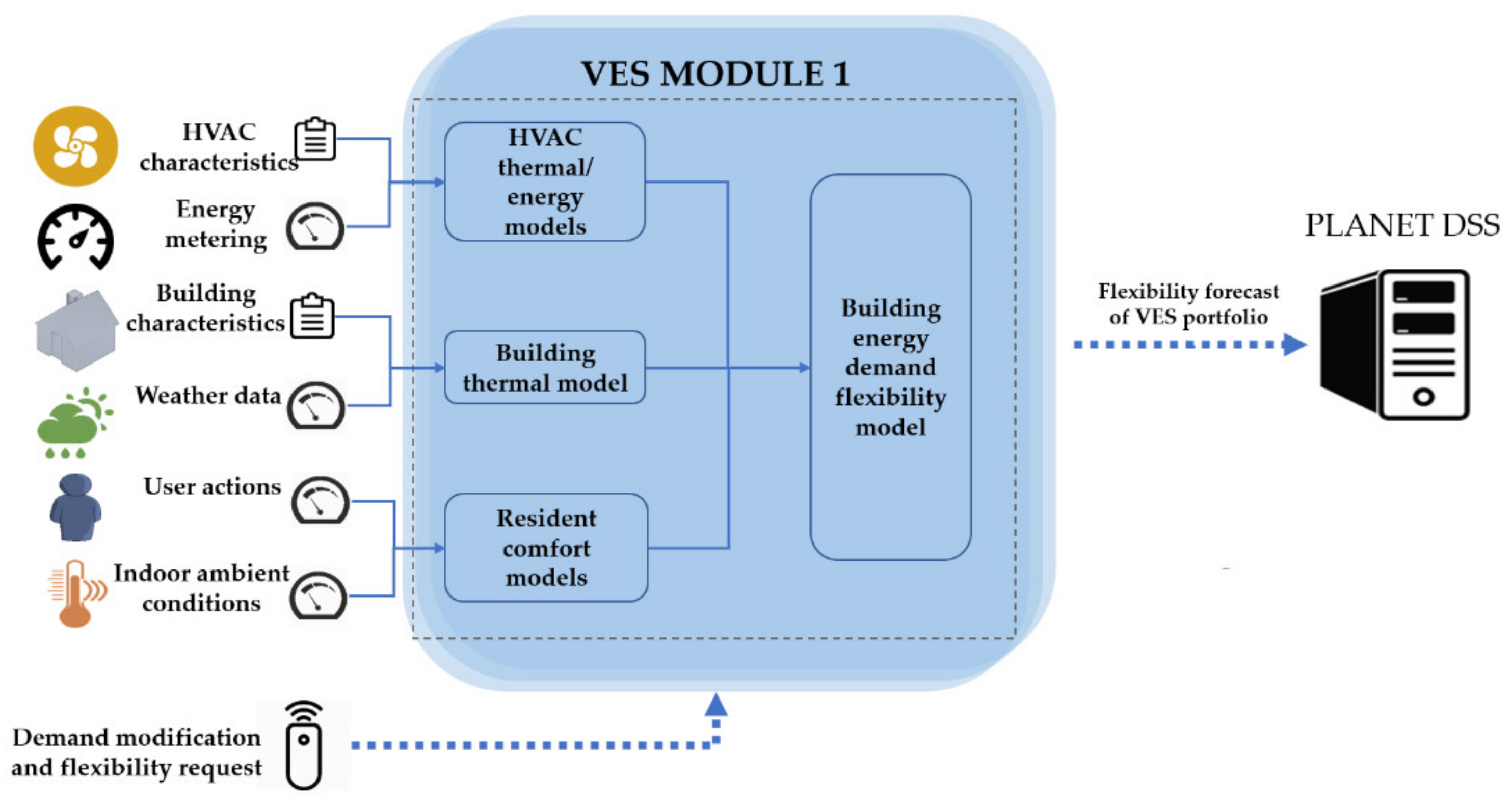
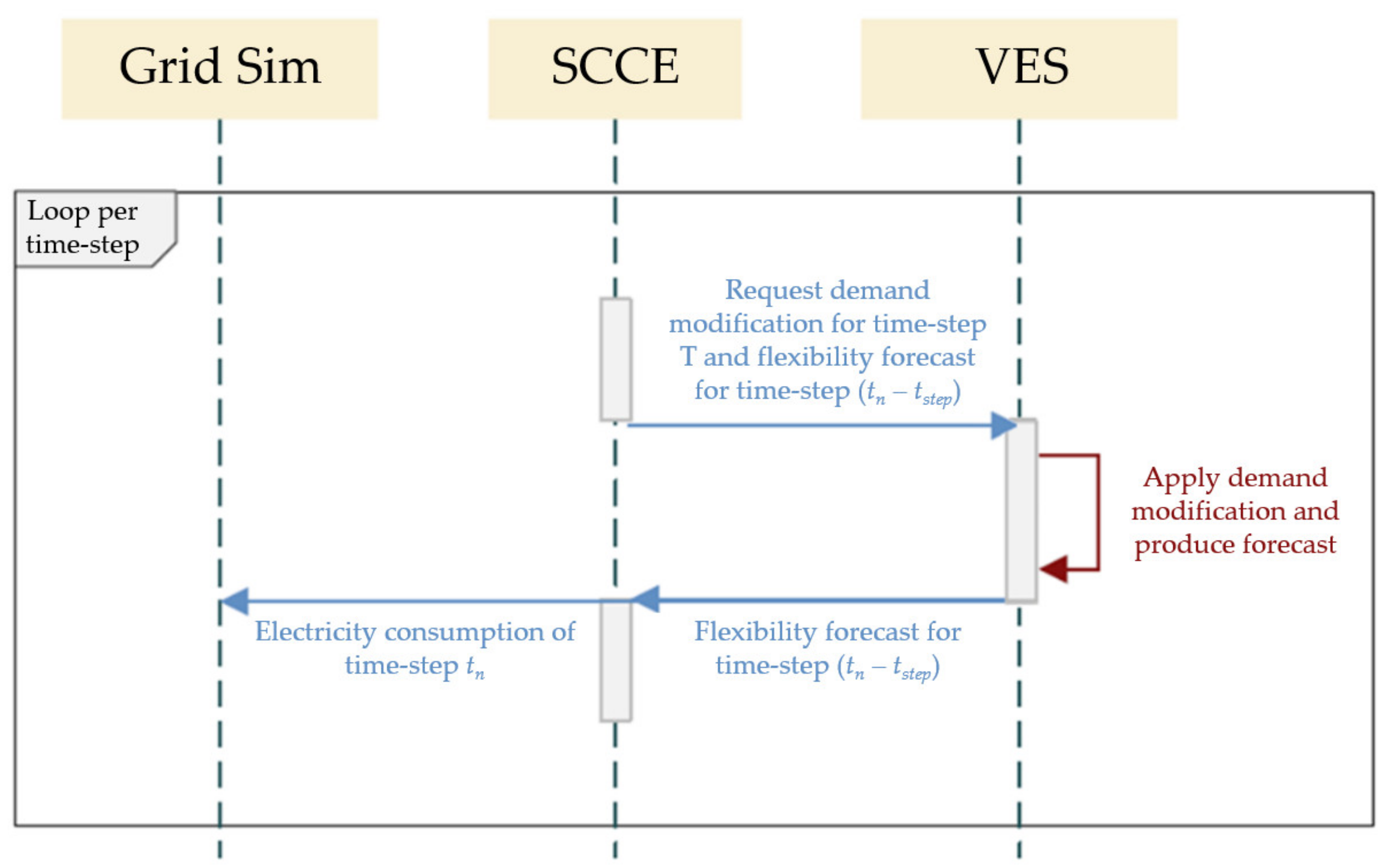
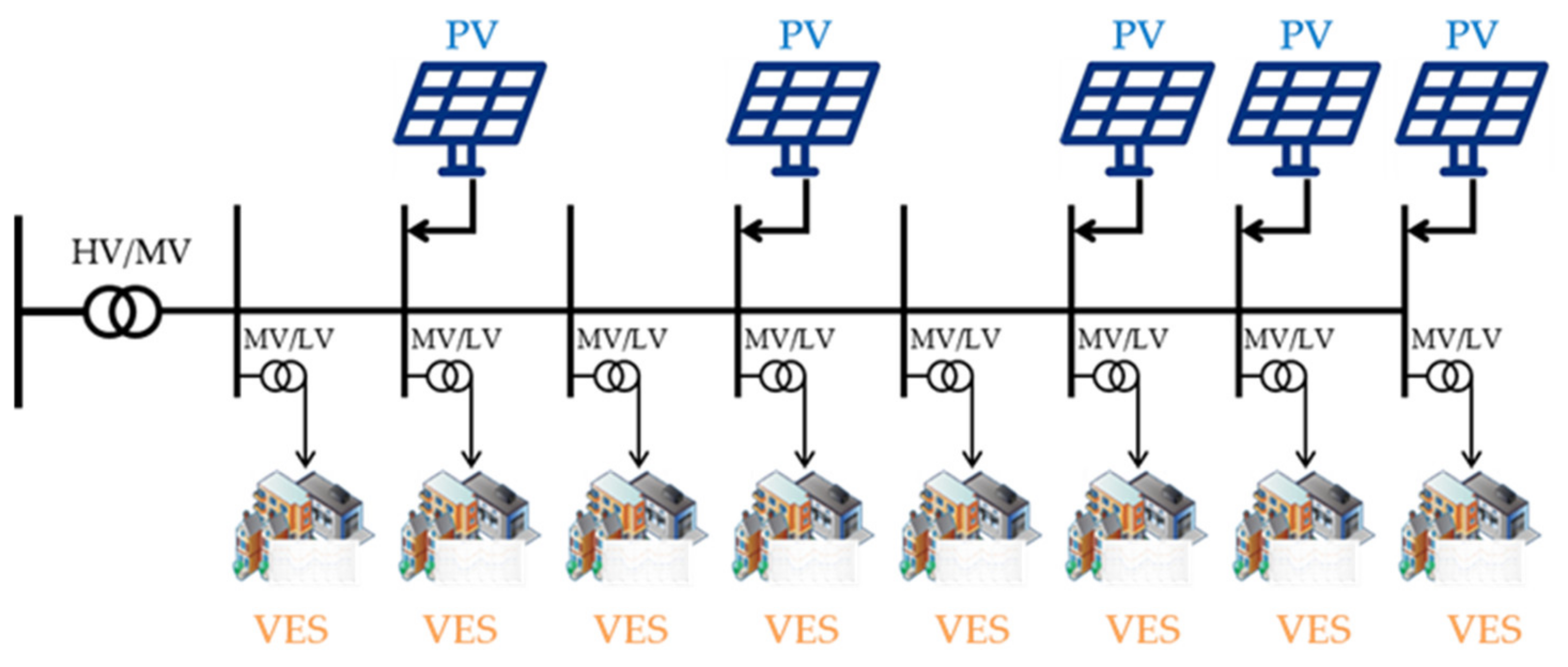

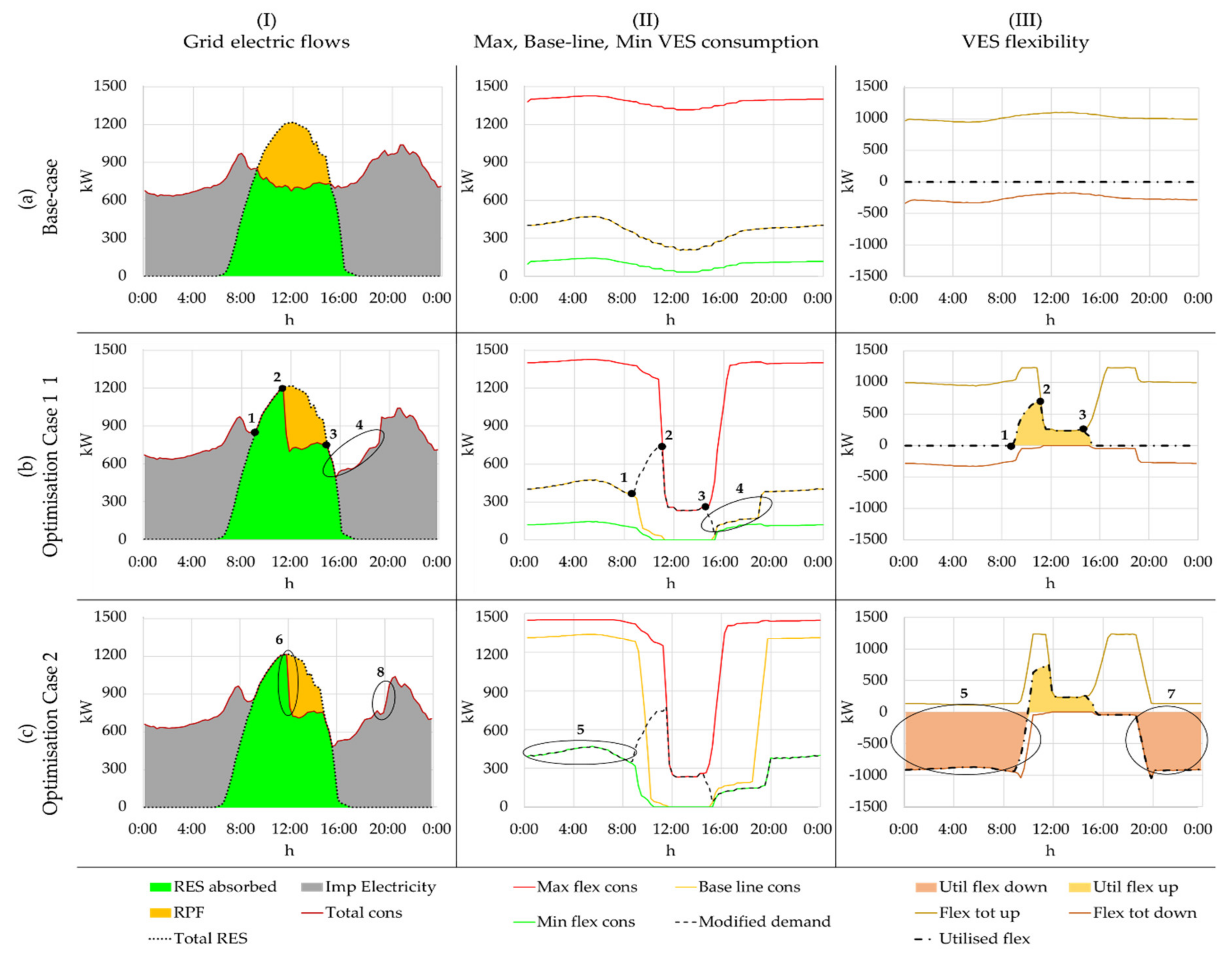
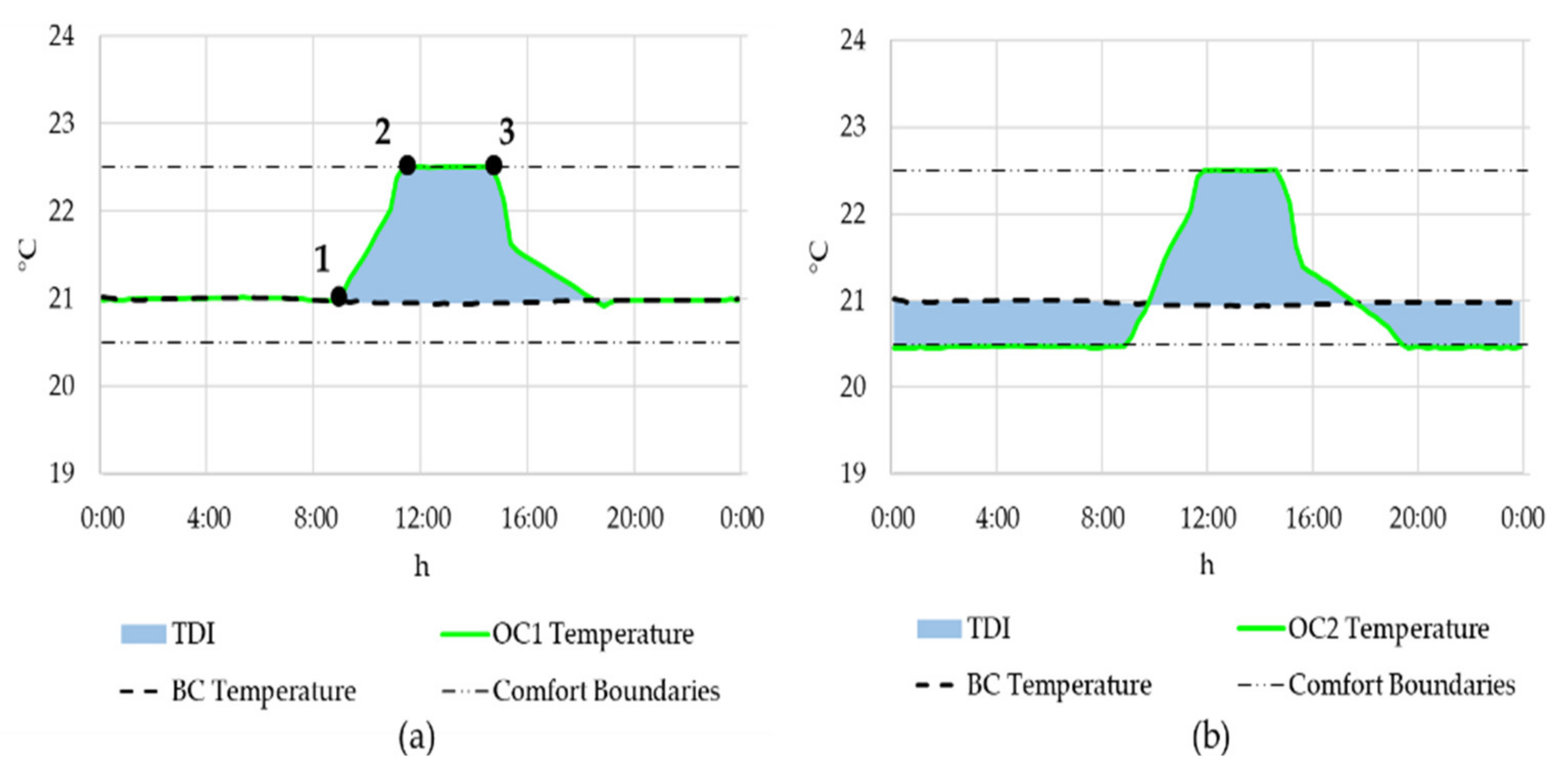
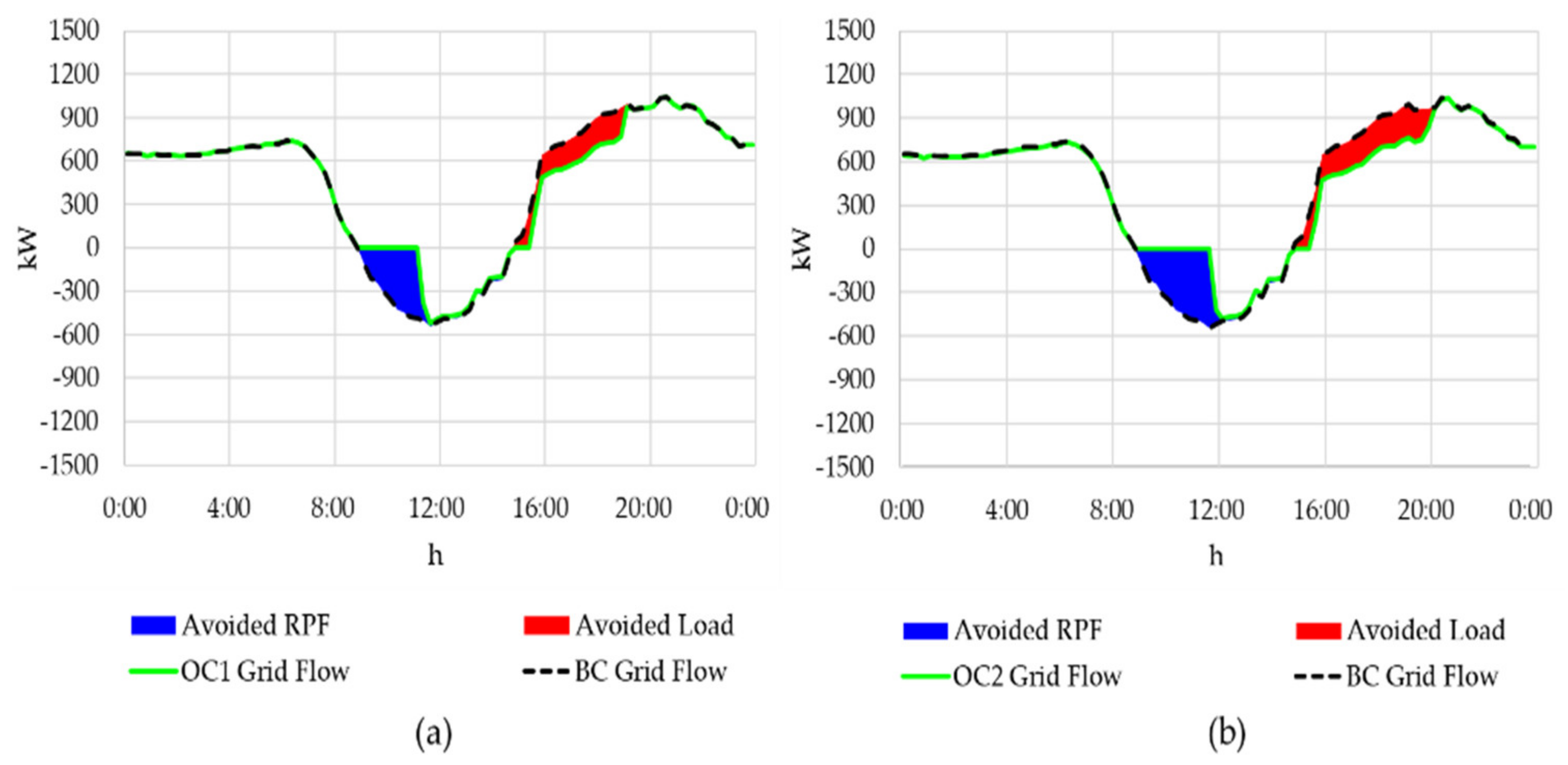
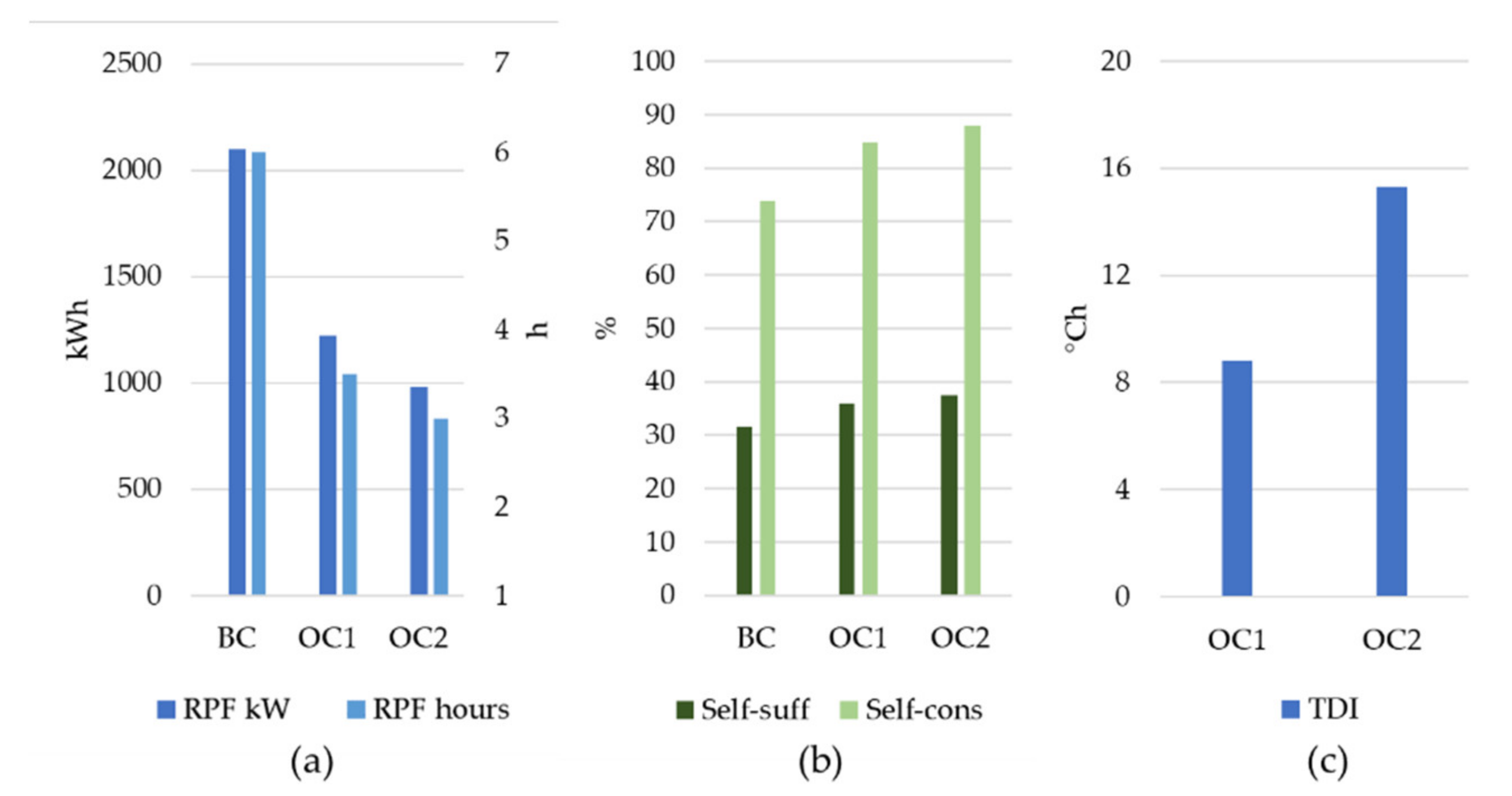
| Variables | Name | Units | Type |
|---|---|---|---|
| Configuration Parameters | |||
| R1, R2, R3 | Conduction, convection and infiltration-related resistances | °C/W | Float |
| C1, C2 | Thermal capacitances | J/°C | Float |
| p1, p2 | Distribution coefficients of the solar gains | - | Float |
| p3, p4 | Distribution coefficients of the electrical heating load | - | Float |
| , | Thermal comfort boundaries | °C | Float |
| Number of residential buildings in the VES Portfolio | - | Integer | |
| Number of commercial buildings in the VES Portfolio | - | Integer | |
| Input Parameters | |||
| Time point | sec | Float | |
| Outdoor temperature forecast | °C | Float | |
| Qsolar | Global horizontal irradiance | W/m2 | Float |
| Initial indoor temperature | °C | Float | |
| Pcons | Demand modification (request to apply consumption) | W | Float |
| Output Parameters | |||
| Upwards flexibility | W | Float | |
| Downwards flexibility | W | Float | |
| Baseline consumption | W | Float | |
| Network Node | PV Nominal Power kW | VES Buildings (Residential and Commercial Users) | Flexible Load Aggregated LP2H kW | Fixed Load kW |
|---|---|---|---|---|
| Node 1 | - | Res: 100. Com: 10 | 520 | 830 |
| Node 2 | 300 | Res: 60. Com: 5 | 310 | 495 |
| Node 3 | - | Res: 80. Com: 20 | 440 | 700 |
| Node 4 | 350 | Res: 50. Com: 15 | 280 | 445 |
| Node 5 | - | Res: 90. Com: - | 450 | 720 |
| Node 6 | 400 | Res: 60. Com: 5 | 310 | 495 |
| Node 7 | 300 | Res: 70. Com: 15 | 380 | 605 |
| Node 8 | 350 | Res: 40. Com: - | 200 | 320 |
| Total | 1700 | Res: 550. Com: 70 | 2890 | 4610 |
© 2020 by the authors. Licensee MDPI, Basel, Switzerland. This article is an open access article distributed under the terms and conditions of the Creative Commons Attribution (CC BY) license (http://creativecommons.org/licenses/by/4.0/).
Share and Cite
Fambri, G.; Badami, M.; Tsagkrasoulis, D.; Katsiki, V.; Giannakis, G.; Papanikolaou, A. Demand Flexibility Enabled by Virtual Energy Storage to Improve Renewable Energy Penetration. Energies 2020, 13, 5128. https://doi.org/10.3390/en13195128
Fambri G, Badami M, Tsagkrasoulis D, Katsiki V, Giannakis G, Papanikolaou A. Demand Flexibility Enabled by Virtual Energy Storage to Improve Renewable Energy Penetration. Energies. 2020; 13(19):5128. https://doi.org/10.3390/en13195128
Chicago/Turabian StyleFambri, Gabriele, Marco Badami, Dimosthenis Tsagkrasoulis, Vasiliki Katsiki, Georgios Giannakis, and Antonis Papanikolaou. 2020. "Demand Flexibility Enabled by Virtual Energy Storage to Improve Renewable Energy Penetration" Energies 13, no. 19: 5128. https://doi.org/10.3390/en13195128
APA StyleFambri, G., Badami, M., Tsagkrasoulis, D., Katsiki, V., Giannakis, G., & Papanikolaou, A. (2020). Demand Flexibility Enabled by Virtual Energy Storage to Improve Renewable Energy Penetration. Energies, 13(19), 5128. https://doi.org/10.3390/en13195128





